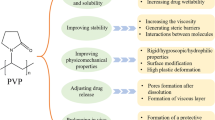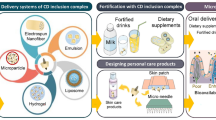Abstract
The present study was conducted to investigate the sustained-release properties of Mimosa pudica seed mucilage. Matrix tablets of diclofenac sodium containing different proportions of mucilage and dibasic calcium phosphate as diluent were formulated by wet granulation method. The tablets had uniform physical appearance, average weight, drug content, and adequate hardness. The results of in vitro release conducted using USP type II dissolution rate apparatus, in a dissolution media comprising of 900 mL of 0.1 N HCl for 2 h followed by phosphate buffer (pH 6.8) for 24 h at 37°C and 50 rpm, revealed that as the proportion of mucilage in the matrix was increased there was a corresponding decrease in the release of drug. Further, the matrix tablets were found to release the drug following Higuchi square root release kinetics, with the mechanism of release being diffusion for tablets containing higher proportion of mucilage and a combination of matrix erosion and diffusion for tablets containing smaller proportion of mucilage. The swelling and erosion studies revealed that, as the proportion of mucilage in tablets was increased, there was a corresponding increase in percent swelling and a decrease in percent erosion of tablets. The SEM photomicrographs showed gelling structures in tablets containing higher percentage of mucilage, while both pores and gelling structures were present on the surface of tablets containing smaller proportion of mucilage and commercial formulation. On comparative evaluation, the dissolution profile from formulation containing mucilage to drug in the proportion of 1:40 was found to be similar to the commercial sustained-release formulation of diclofenac.




Similar content being viewed by others
References
Isimi CY, Kunle OO, Bangudu AB. Some emulsifying and suspending properties of the mucilage extracted from kernels of Irvingia gabonensis. Boll Chim Farm. 2000;139:199–204.
Ndjouenkeu R, Akingbala JO, Oguntimein GB. Emulsifying properties of three African food hydrocolloids: okra (Hibiscus esculentus), dika nut (Irvingia gabonensis), and khan (Beilschmiedia sp.). Plant Foods Hum Nutr. 1997;51:245–55.
Anroop B, Bhatnagar SP, Ghosh B, Parcha V. Studies on Ocimum gratissimum seed mucilage: evaluation of suspending properties. Indian J Pharm Sci. 2005;67:206–9.
Anroop B, Ghosh B, Parcha V, Vasanti S. Studies on Ocimum gratissimum seed mucilage: evaluation of binding properties. Int J Pharm. 2006;325:191–3.
Ghule BV, Darwhekar GD, Jain DK, Yeole PG. Evaluation of binding properties of Eulophia campestris Wall. mucilage. Indian J Pharm Sci. 2006;68:566–9.
Patel DM, Prajapati DG, Patel NM. Seed mucilage from Ocimum americanum linn. as disintegrant in tablets: separation and evaluation. Indian J Pharm Sci. 2007;69:431–5.
Bhardwaj TR, Kanwar M, Lal R, Gupta A. Natural gums and modified natural gums as sustained-release carriers. Drug Dev Ind Pharm. 2000;26:1025–38.
Baveja SK, Rao KVR, Arora J. Examination of natural gums and mucilages as sustaining materials in tablet dosage forms. Indian J Pharm Sci. 1988;50:89–92.
Jani GK, Shah DP. Evaluation of mucilage of Hibiscus rosasinensis Linn as rate controlling matrix for sustained release of diclofenac. Drug Dev Ind Pharm. 2008;34:807–16.
Trease GE, Evans MC, editors. Textbook of pharmacognosy. 15th ed. London: Balliere Tindall; 2002.
Himalaya Herbal Healthcare. Herbal monograph: Mimosa pudica. Himalaya Herbal Healthcare Website. http://www.himalayahealthcare.com/herbfinder/h_mimosa.htm. Accessed 2 June 2008.
Yadav P. Evaluation of Mimosa pudica mucilage for binding and disintegrating properties. M. Pharm Dissertation submitted to Guru Jambheshwar University of Science and Technology, Hisar, Haryana, India; 2007.
World Health Organization. Quality control methods for medicinal plant materials. Geneva: World Health Organization; 1998.
Banker GS, Anderson NR. Tablets. In: Lachman L, Lieberman HA, Kanig JL, editors. The theory and practice of industrial pharmacy. 3rd ed. Bombay: Varghese; 1987. p. 293–345.
Indian Pharmacopoeia Commission. Tablets. Indian Pharmacopoeia, vol. 2. Ghaziabad: Indian Pharmacopoeia Commission, Govt. of India, Ministry of Health and Family Welfare; 2007. p. 662–5.
Su SF, Chou CH, Kung CF, Huang J. In vitro and in vivo comparison of two diclofenac sodium sustained release oral formulations. Int J Pharm. 2003;260:39–46.
Costa P, Lobo JMS. Modeling and comparison of dissolution profiles. Eur J Pharm Sci. 2001;13:123–33.
Pillay V, Fassihi R. Evaluation and comparison of dissolution data derived from different modified release dosage forms: an alternative method. J Control Release. 1998;55:45–55.
Shah VP, Tsong Y, Sathe P, Liu JP. In vitro dissolution profile comparison—statistics and analysis of the similarity factor, f2. Pharm Res. 1998;15:889–96.
Al-Taani BM, Tashtoush BM. Effect of microenvironment pH of swellable and erodible buffered matrices on the release characteristics of diclofenac sodium. AAPS PharmSciTech. 2003;4(3):110–5.
Lund W. The pharmaceutical codex: principles and practice of pharmaceutics. London: Pharmaceutical Press; 1994.
Ravi PR, Ganga S, Saha RN. Design and study of lamivudine oral controlled release tablets. AAPS PharmSciTech. 2007;8(4):167–75.
Mukherjee B, Dinda SC, Barik BB. Gum cordia: a novel matrix forming material for enteric resistant and sustained drug delivery- a technical note. AAPS Pharm Sci Tech. 2008;9(1):330–3.
Tajarobi F, Abrahmsen-Alami S, Hansen M, Larsson A. The impact of dose and solubility of additives on the release from hpmc matrix tablets—identifying critical conditions. Pharm Res. 2009;26:1496–503. doi:10.1007/s11095-009-9861-y.
Jamzad S, Tutunji L, Fassihi R. Analysis of macromolecular changes and drug release from hydrophilic matrix systems. Int J Pharm. 2005;292:75–85.
Colombo P, Bettini R, Santi P, Peppas AN. Swellable matrices for controlled drug delivery: gel-layer behaviour, mechanisms and optimal performance. Pharm Sci Technol Today. 2000;3:198–204.
Acknowledgements
The authors are grateful to Dabur Research Foundation, Ghaziabad, India for generous gift samples of diclofenac and SAIF, AIIMS, New Delhi, India, for SEM analysis.
Author information
Authors and Affiliations
Corresponding author
Rights and permissions
About this article
Cite this article
Singh, K., Kumar, A., Langyan, N. et al. Evaluation of Mimosa pudica Seed Mucilage as Sustained-Release Excipient. AAPS PharmSciTech 10, 1121–1127 (2009). https://doi.org/10.1208/s12249-009-9307-1
Received:
Accepted:
Published:
Issue Date:
DOI: https://doi.org/10.1208/s12249-009-9307-1




